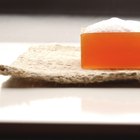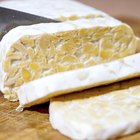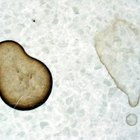
Jupiterimages/Polka Dot/Getty Images
Proper hygiene—especially frequent hand washing—is well known to be one of the easiest, most effective ways of preventing the spread of illness. The formulas for hand soaps aim to best cleanse the hands of dirt, grease and bacteria. Several types of ingredients are integral to maintaining the cleansing properties of hand soap.
Surfactant
The surfactant is the main active ingredient in any hand soap. This ingredient chemically modifies the properties of water to make it a more effective cleanser. The surfactant also dissolves soils and emulsifies greasy substances. Chemicals, such as alcohol derivatives or sulfate compounds, are among the most commonly used surfactants.
Builders
Builders are ingredients in soaps that increase the effectiveness of the product. They remove minerals from the water by chelation or precipitation. In addition, they help with the removal of grease and bond with the soil particles, preventing them from resettling on the skin. Builders include complex phosphates and many different sodium compounds.
Alkalis
Since soil and grease are often acidic, a soap will clean more effectively if it is alkaline. Hand soap includes ingredients, such as ammonium hydroxide, ethanolamines and sodium compounds, to increase the alkalinity and counteract the acidity of other ingredients. These chemicals are often classified with other builders.
Antimicrobal Agents
An important part of hand soap is its antibacterial properties. The ingredients added to kill bacteria include ammonium products, hydrogen peroxide, triclosan and certain plant oils such as pine oil. Antimicrobal agents are necessary for hand soaps because touching spreads most contagious illnesses, and frequent hand washing with antibacterial soap lessens the risk of disease.
Other Ingredients
Most hand soaps include other ingredients such as abrasives, fragrances and coloring agents. Abrasives, such as quartz or sand, exfoliate the skin and remove stubborn soils. Fragrances, usually made of plant oils, mask the scent of other ingredients and add pleasant, distinctive scents, while colorants improve the attractiveness of the product.
Related Articles

What Ingredients Are in Detergent?

Ingredients in Facial Cleansers

Corn Huskers Lotion Ingredients

Merle Norman Ingredients

Phisoderm Ingredients

Palmolive Shampoo Ingredients

What Is Hand Salve?

Difference Between Soap & Synthetic ...

Importance of a Soap Detergent

The Ingredients of Neutrogena Sensitive ...

Will Cream of Tartar Whiten Teeth?

How Does Homemade Soap Compare to ...

Noxzema Ingredients

Coppertone Ingredients

Ingredients of Bar Soap

Foods High in Probiotics & Electrolytes

Ingredients in Maybelline Foundation

Ingredients in Dial Liquid Soap

Is Allantoin a Relative of the Lanolin ...

How Does Shout Work to Remove Stains?
References
Photo Credits
Jupiterimages/Polka Dot/Getty Images